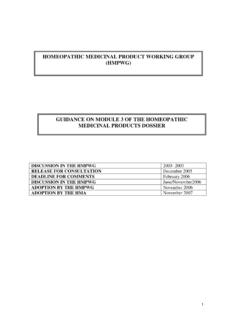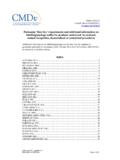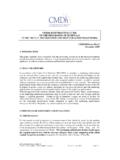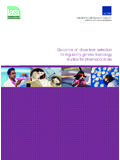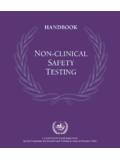Transcription of NOTE: The CMD(h) ‘Annotated’ QRD Template …
1 Co-ordination Group for Mutual Recognition and Decentralised Procedures - Human CMD(h) ANNOTATED QRD Template FOR MR/DC PROCEDURES. (Based on version of the QRD Template for CP). November 2005. Revision 3, October 2006. NOTE: The CMD(h) Annotated' QRD Template provides guidance on how to present the SPC, Labelling and Package Leaflet for an application in the Mutual Recognition or Decentralised Procedure. The clean' QRD Template for use in a MRP, DCP or referral procedure is published in all languages on the website of the EMEA. SUMMARY OF PRODUCT CHARACTERISTICS. [NOTE: the following are those items of information required by Article 11 of Directive 2001/83/EC, as amended, for the Mutual Recognition Procedure and the Decentralised Procedure.]
2 This guidance should be read in conjunction with the relevant guidelines that can be found on the EMEA website (See also Convention for format and layout): , in particular the Guideline on Summary of Product Characteristics as published on the Website of the European Commission in the Notice to Applicants, Volume 2C: #2c During the evaluation process, applicants may present SPCs for different strengths in one document, clearly indicating with grey-shaded titles the strength or presentation to which alternative text elements refer. Upon MS agreement with a combined SPC text, the text does not need to be separated in the national phase of marketing authorisation.
3 However, in all other cases, a separate SPC per strength and per pharmaceutical form, containing all pack-sizes related to the strength and pharmaceutical form concerned will have to be provided by the applicant as follows: - English language version: immediately after agreement on final SPC. - All other language versions: at latest 5 days after the end of the Mutual Recognition or Decentralised Procedure. Standard statements are given in the Template , which must be used whenever they are applicable. If the applicant needs to deviate from these statements to accommodate product-specific requirements, alternative or additional statements will be considered on a case-by-case basis.
4 Bracketing convention: {text}:Information to be filled in <text>:Text to be selected or deleted as appropriate]. CMD(h) Annotated QRD Template for MR/DC Procedures October 2006 Page 1/20. 1. NAME OF THE MEDICINAL PRODUCT. {(Invented) name strength pharmaceutical form}. [Name of the medicinal product in the RMS.]. [no symbols attached here and throughout the text; tablets and capsules in the plural.]. 2. QUALITATIVE AND QUANTITATIVE COMPOSITION. [Name of the active substance(s) in the language of the text.]. [Qualitative and quantitative composition in terms of the active substances and constituents of the excipient, knowledge of which is essential for proper administration of the medicinal product.
5 The usual common name or chemical description shall be used. See also the Guideline on excipients as published on the Website of the European Commission in the Notice to Applicants, Volume 3B. #3b]. <Excipient(s):>. For a full list of excipients, see section 3. PHARMACEUTICAL FORM. [The pharmaceutical form should be stated according to the full Standard Terms published by the Council of Europe, in the singular. Where the Council of Europe short standard term is used on small immediate packaging materials, the short term should be added in brackets.]. [Include here a description of the visual appearance of the product pharmaceutical form as marketed, including information on pH and osmolarity as required.
6 Information on appearance of reconstituted parenteral solution should appear under section ]. <The score line is only to facilitate breaking for ease of swallowing and not to divide into equal doses.>. <The tablet can be divided into equal halves.>. 4. CLINICAL PARTICULARS. Therapeutic indications [Specify, if appropriate <This medicinal product is for diagnostic use only.>. If applicable, results of clinical trials to appear under section ]. Posology and method of administration [In case of restricted medical prescription start this section by specifying the conditions. Method of administration: directions for proper use by healthcare professionals or by the patient.
7 Further practical details for the patient can be included in the package leaflet, in the case of inhalers, subcutaneous self-injection. Instructions for preparation are to be placed under section or 12, and cross-referenced here.]. <{(Invented) name} is not recommended for use in children <above> <below> {age Y} due to <a lack of>. <insufficient> data on <safety> <and> <or> <efficacy> <(see section < > < >).>. <The experience in children is limited.>. CMD(h) Annotated QRD Template for MR/DC Procedures October 2006 Page 2/20. <There is no experience in children> <(see section < > < >).>. <There is no relevant indication for use of {(Invented) name} in children.
8 >. <{(Invented) name} is contraindicated in children (see section ).>. Contraindications <Hypersensitivity to the active substance(s) or to any of the excipients <or {name of the residue(s)}>.>. Special warnings and precautions for use Interaction with other medicinal products and other forms of interaction <No interaction studies have been performed.>. <Interaction studies have only been performed in adults.>. Pregnancy and lactation [For Pregnancy and lactation statements see Appendix I.]. [Results from reproduction toxicology to be included under section and cross-referenced here, if necessary.]. Effects on ability to drive and use machines <{Invented name} has <<no> or negligible> influence> <minor or moderate influence> <major influence>.
9 On the ability to drive and use machines.> [describe effects where applicable]. <No studies on the effects on the ability to drive and use machines have been performed.>. <Not relevant.>. Undesirable effects [MedDRA frequency convention and system organ class database, see Appendix II.]. Within each frequency grouping, undesirable effects are presented in order of decreasing seriousness. Overdose [Describe the symptoms, emergency procedures, and antidotes (if available) in case of overdose.]. <No case of overdose has been reported.>. 5. PHARMACOLOGICAL PROPERTIES. Pharmacodynamic properties Pharmacotherapeutic group: {group [lowest available level]}, ATC code: {code}.
10 [For products approved under exceptional circumstances , include the following statement:]. <This medicinal product has been authorised under Exceptional Circumstances . This means that <due to the rarity of the disease> <for scientific reasons> <for ethical reasons> it has not been possible to obtain complete information on this medicinal product. The {name MS/Agency} will review any new information which may become available every year and this SPC will be updated as necessary>. Pharmacokinetic properties CMD(h) Annotated QRD Template for MR/DC Procedures October 2006 Page 3/20. preclinical safety data <Non-clinical data reveal no special hazard for humans based on conventional studies of safety pharmacology, repeated dose toxicity, genotoxicity, carcinogenic potential, toxicity to reproduction.
